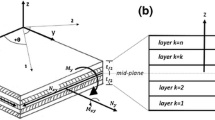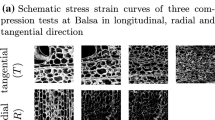Abstract
A rheological model to describe the development of the vertical density profile and of internal stresses within wood-furnish mats during hot pressing is presented in this paper. The rheological model is part of a comprehensive three-dimensional simulation model that accounts for those mechanisms most important during the pressing process, including heat and mass transfer inside the mat and adhesive cure.
To model the rheological behavior of the mat, the four-element Burgers model commonly used to describe visco-elastic material behavior has been expanded with the addition of a fifth element that represents plastic and micro-fracture related deformation. The coefficients of the non-linear model are highly dependent on the material conditions. Equations of the coefficients as a function of temperature, moisture content and density, as well as a mathematical formulation of the five-element model is presented in this paper. Furthermore, model predictions for both a batch and a continuous press are given. A comparison with experimental results shows that the expanded Burgers model is suitable to predict typical features of the vertical density profile, such as the development of density maxima near the surfaces, shoulders or side maxima as a consequence of intermediate or final densification steps, and differences in the density profile between the mat center and the edges in the horizontal plane. Such agreement provides the basis for a wide range of industrial and research applications.
Zusammenfassung
Im vorliegenden Artikel wird ein rheologisches Modell zur Beschreibung der Entwicklung des Dichteprofils senkrecht zur Plattenebene sowie der Spannungen innerhalb des Holzwerkstoffvlieses während des Heisspressens vorgestellt. Das rheologische Modell ist Bestandteil eines umfassenden drei-dimensionalen Simulationsmodells, welches weitere für den Pressvorgang wichtige Vorgänge wie Wärme- und Stofftransport und Klebharzaushärtung beinhaltet.
Zur Modellierung des rheologischen Vliesverhaltens wurde das aus vier Elementen bestehende Burgers-Modell, das sich zur Beschreibung von visko-elastischen Verformungen eignet, um ein fünftes Element für plastische und microbruchinduzierte Verformungen ergänzt. Die Koeffizienten des nicht-linearen Modells hängen in starkem Masse vom Vlieszustand ab. Gleichungen zur Beschreibung der Koeffizienten als Funktion von Temperatur, Feuchte und Dichte werden zusammen mit der mathematischen Formulierung des Fünf-Elemente-Modells präsentiert. Darüber hinaus werden Modellrechnungen sowohl für Takt- als auch für Doppelbandpressen dargestellt. Ein Vergleich mit experimentellen Ergebnissen zeigt, dass das erweiterte Burgers-Modell für die Vorhersage der charakteristischen Merkmale eines Dichteprofils geeignet ist; charakteristisch sind die Entwicklung von oberflächennahen Dichtemaxima, von Schultern oder Zwischenmaxima als Folge von Zwischen- oder Nachverdichtungsschritten sowie Unterschiede im Dichteprofil zwischen der horizontalen Mattenmitte und den Kanten. Die gute Übereinstimmung zwischen Simulation und Experiment bietet die Grundlage für den Einsatz des Simulationsmodells für eine Reihe von Anwendungen in Industrie und Forschung.
Similar content being viewed by others
References
Bodig J, Jayne BA (1982) Mechanics of wood and wood composites. Van Nostrand Reinhold Company, New York, p 712
Boehme C (1992) Die Bedeutung des Rohdichteprofils für MDF. Holz Roh- Werkst 50:18–24
Dai C, Knudson B, Wellwood R (2000) Research and Development in Oriented Strand Board (OSB) Processing. In: Proc. of the 5th Pacific Rim Bio-Based Composites Symposium, Canberra, pp 556–563
Fahrni F (1956) Das Verpressen von Spanplatten bei gefeuchteten oder feuchteren Deckspänen. Holz Roh- Werkst 14(1):8–10
von Haas G (1998) Untersuchungen zur Heisspressung von Holzwerkstoffmatten unter besonderer Berücksichtigung des Verdichtungsverhaltens, der Permeabilität, der Temperaturleitfähigkeit und der Sorptionsgeschwindigkeit. Dissertation, Univ. Hamburg, Germany, p 264
Haselein CR (1998) Numerical simulation of pressing wood-fiber composites. Ph.D. Thesis, Oregon State Univ., USA, p 244
Humphrey PE (1994) Engineering composites from oriented natural fibres: A strategy. In: Proc of the 2nd Pacific Rim Bio-Based Composites Symp., Vancouver, Canada, pp 2–8
Kehr E, Schölzel S (1965) Untersuchungen über das Press-Diagramm zur Herstellung von Spanplatten. Drevarsky Vyskum 10(7):133–147
Kollmann F (1957) Über den Einfluss von Feuchtigkeitsunterschieden im Spangut vor dem Verpressen auf die Eigenschaften von Holzspanplatten. Holz Roh- Werkst 15(1):35–44
Kollmann F (1961) Rheologie und Strukturfestigkeit von Holz. Holz Roh- Werkst 19(7):73–80
Kull W (1963) Die Dichte von Holz und Holzwerkstoffen. Holz-Zentralblatt 89:125–131
Lang EM, Wolcott MP (1996) A model for visoelastic consolidation of wood-strand mats. Part II. Static stress-strain behavior of the mat. Wood Fiber Sci 28(7):369–379
Lenth CA, Kamke FA (1996) Investigations of flakeboard mat consolidation. Part II. Modeling mat consolidation using theories of cellular materials. Wood Fiber Sci 28(7):309–319
Liiri O (1969) Der Pressdruck bei der Spanplattenherstellung. Holz Roh- Werkst 27(8):371–378
May H-A, Mehlhorn L (1969) Verbesserung der Pressbedingungen durch die Anwendung von Regelsystemen anstelle von Programmsteuerungen. Holz-Zentralblatt 86:1342–1348
Pierce CB, Dinwoodie JM (1977) Creep in chipboard. Part I. Fitting 3- and 4-element response curves to creep data. J Mater Sci 12:1955–1960
Plath E (1971) Beitrag zur Mechanik der Holzspanplatten. Holz Roh- Werkst 29(8):377–382
Raczkowski J (1969) Der Einfluss von Feuchtigkeitsänderungen auf das Kriechverhalten des Holzes. Holz Roh- Werkst 27(6):232–237
Ren S (1991) Thermo-hygro rheological behavior of materials used in the manufacture of wood-based composites. Ph.D. Thesis, Oregon State Univ., USA, p 226
Steffen A, von Haas G, Rapp A, Humphrey PE, Thömen H (1999) Temperature and gas pressure in MDF-mats during industrial continuous hot pressing. Holz Roh- Werkst 57:154–155
Steiner PR, Dai C (1993) Spatial structure of wood composites in relation to processing and performance characteristics. Part I. Rationale and model development. Wood Sci Tech 28:45–51
Thoemen H (2000) Modeling the Physical Processes in Natural Fiber Composites During Batch and Continuous Pressing. Ph.D. Thesis, Oregon State Univ., USA, p 187
Thoemen H, Humphrey PE (2003) Modeling the continuous pressing process for wood-based composites. Wood Fiber Sci 35(7):456–468
Thoemen H, Humphrey PE (2005) Modeling the physical processes relevant during hot pressing of wood-based composites. Part I. Heat and mass transfer. (Submitted to Holz Roh- Werkst)
Wang S, Winistorfer PM, Moschler WW, Helton C (2000) Hot-pressing of oriented strandboard by step-closure. For Prod J 50(7):28–34
Winistorfer P, Moschler W, Wang S, DePaula E, Bledsoe BL (2000) Fundamentals of vertical density profile formation in wood composites. Part 1. In-situ density measurement of the consolidation process. Wood Fiber Sci 32(2):209–219
Zombori BG (2001) Modeling the transient effects during the hot-compression of wood-based composites. Ph.D. Thesis. Virginia State Univ., USA. p 212
Author information
Authors and Affiliations
Corresponding author
Rights and permissions
About this article
Cite this article
Thoemen, H., Haselein, C. & Humphrey, P. Modeling the physical processes relevant during hot pressing of wood-based composites. Part II. Rheology. Holz Roh Werkst 64, 125–133 (2006). https://doi.org/10.1007/s00107-005-0032-5
Published:
Issue Date:
DOI: https://doi.org/10.1007/s00107-005-0032-5




